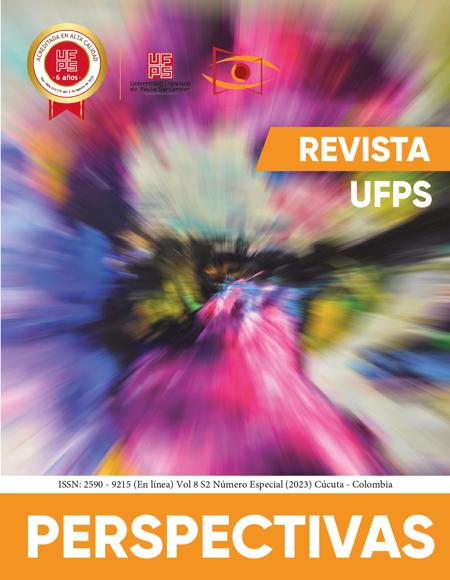Analysis of the impact of the scientific production of the program Fonoaudiología de la Universidad de Pamplona entre los años 2005-2022
Análisis del impacto de la producción científica del programa de Fonoaudiología de la Universidad de Pamplona entre los años 2005 – 2022
Main Article Content
The United Nations Educational, Scientific and Cultural Organization-UNESCO in its world declaration on higher education in the 21st century, proclaimed that the three functions of Higher Education Institutions are: Teaching, Research and Social Projection. It is for this reason that the undergraduate academic program in Speech Fonoaudiología at the University of Pamplona has competent teachers who participate in technology and scientific research, generating a large number of productions and causing innovation and contribution of new knowledge as a result of the investigative process. Based on this, a bibliometric, descriptive cross-sectional study on scientific production is carried out with the objective of analyzing the impact of the publications of the teachers of the program, where the "Publish or Perish" software was used, which allowed the establishment of the index of impact of scientific journals through the count of citations located in Google Scholar. Allowing to determine that both the number of products analyzed and their impact, represent an increase in the quantity and quality of research productions in the last 17 years.
Downloads
Publication Facts
Reviewer profiles N/A
Author statements
- Academic society
- Universidad Francisco de Paula Santander
- Publisher
- Universidad Francisco de Paula Santander
Article Details
Cobo Sánchez, J. L., Ochando-García, A., Blanco Mavillard, I., Cirera Segura, F., Crespo Montero, R., & Casas Cuestas, R. (2018). Análisis del impacto de la producción científica de la revista Enfermería Nefrológica entre 1998 y 2017. Enfermería nefrológica, 21(4), 349–358. https://doi.org/10.4321/s2254-28842018000400004 DOI: https://doi.org/10.4321/S2254-28842018000400004
Sarmiento Tovar, J. J. (2020). Factores asociados a la productividad científica de docentes investigadores. Sinergias Educativas, 5(1). https://doi.org/10.37954/se.v5i1.52 DOI: https://doi.org/10.37954/se.v5i1.52
UNESCO. (1998). DECLARACIÓN MUNDIAL SOBRE LA EDUCACIÓN SUPERIOR EN EL SIGLO XXI: VISIÓN y ACCIÓN. Revista Educación Superior y Sociedad (ESS), 9(2), 97–113. https://www.iesalc.unesco.org/ess/index.php/ess3/article/view/171
Cárdenas Torrado, L., Álvarez Cardona, N., & Cruz Casallas, N. E. (2020). Impacto de la investigación dentro del proceso de formación profesional. Cultura Educación y Sociedad, 11(2), 145–160. https://doi.org/10.17981/cultedusoc.11.2.2020.09 DOI: https://doi.org/10.17981/cultedusoc.11.2.2020.09
Ayala Bolaños, M. G., Valencia Cruzaty, L. E. (2020). La gestión de la investigación como variable para mejorar la calidad de la Educación Superior en el Ecuador. Neutrosophic Computing and Machine Learning, 14 (1). de http://fs.unm.edu/NCML2/index.php/112/Articulo2
Rivera, C., Lizleth, D.-., Feria-Duarte, ;., & Rodríguez-Carvajal, ;. (2020). History of the speech therapy program at the University of Pamplona. Recuperado el 14 de noviembre de 2022, de http://repositoriodspace.unipamplona.edu.co/jspui/bitstream/20.500.12744/2667/1/Rodr%C3%ADguez_Feria_Rico_2020_TG.pdf
Castillo-Esparcia, A., Rubio-Moraga, Á., & Almansa-Martínez, A. (2012). La investigación en Comunicación. Análisis bibliométrico de las revistas de mayor impacto del ISI. Revista Latina de Comunicación Social , (67), 248-270, de https://www.redalyc.org/articulo.oa?id=81923566006 DOI: https://doi.org/10.4185/RLCS-067-955-248-270
Buela Casal, G. (2003). Evaluación de la calidad de los artículos y de las revistas científicas: Propuesta del factor de impacto ponderado y de un índice de calidad. Psicothema, 15(1), 23–35. https://www.redalyc.org/articulo.oa?id=72715105
Dávalos-Sotelo, R. (2015). Una forma de evaluar el impacto de la investigación científica. Madera y bosques, 21. https://doi.org/10.21829/myb.2015.210422 DOI: https://doi.org/10.21829/myb.2015.210422
López, J. M. T., & de Pablos Coello, J. M. (2013). El “índice h” en las estrategias de visibilidad, posicionamiento y medición de impacto de artículos y revistas de investigación. Investigar la Comunicación hoy. Revisión de políticas científicas y aportaciones metodológicas: Simposio Internacional sobre Política Científica en Comunicación, 133–150. https://dialnet.unirioja.es/servlet/articulo?codigo=4227310
Chiroque-Solano, R., & Padilla-Santoyo, P. (2009). Análisis de coautoría en la revista Biblios: Una aproximación desde Google Scholar. Biblios, 34. https://www.redalyc.org/articulo.oa?id=16118948001
De La Ossa, J., V., Montes-Vergara, D., González-Tous, M., & Salgado-Arroyo, L. C. (2019). Análisis bibliométrico de la Revista Colombiana de Ciencia Animal – RECIA 2009-2018. Indicadores de producción. Revista Colombiana de Ciencia Animal - RECIA, 11(1), 724. https://doi.org/10.24188/recia.v11.n1.2019.724 DOI: https://doi.org/10.24188/recia.v11.n1.2019.724
Delgado, E. y Repiso, R. (2013). El impacto de las revistas de comunicación: comparando Google Scholar Metrics, Web of Science y Scopus. Comunicar , XXI (41), 45-52. http://dx.doi.org/10.3916/C41-2013-04 DOI: https://doi.org/10.3916/C41-2013-04
Gálvez Toro, Alberto, & Amezcua, Manuel. (2006). El factor h de Hirsch: the h-index: Una actualización sobre los métodos de evaluación de los autores y sus aportaciones en publicaciones científicas. Index de Enfermería, 15(55), 38-43. Recuperado en 24 de noviembre de 2022, de http://scielo.isciii.es/scielo.php?script=sci_arttext&pid=S1132-12962006000300009&lng=es&tlng=es. DOI: https://doi.org/10.4321/S1132-12962006000300009
Romero-Torres, M., Acosta-Moreno, L. A., & Tejada-Gómez, M. A. (2013). Ranking de revistas científicas en Latinoamérica mediante el índice h: estudio de caso Colombia. Revista espanola la de documentacion cientifica, 36(1), e003. https://doi.org/10.3989/redc.2013.1.876 DOI: https://doi.org/10.3989/redc.2013.1.876
Túñez López, M. (2014). Impacto de la investigación y de los investigadores en Comunicación en Latinoamérica: el índice h de las revistas científicas. Palabra Clave - Revista de Comunicación, 17(3), 895–919. https://doi.org/10.5294/pacla.2014.17.3.14 DOI: https://doi.org/10.5294/pacla.2014.17.3.14
SNIES. (2020). Colombia es el quinto país con mayor producción científica en América Latina - Sistemas información. Gov.co. Recuperado el 25 de noviembre de 2022, de https://www.mineducacion.gov.co/sistemasdeinformacion/1735/w3-article-245356.html?_noredirect=1
López-Cózar, E. D., & Martín-Martín, A. (2019). Indice H de las revistas cientificas españolas en Google Scholar Metrics 2014-2018. https://www.revistacomunicar.com/pdf/documentos/2019-INDICE-H-2014-2018.pdf
Marzal-Felici, J., Rodríguez-Serrano, A., & Soler-Campillo, M. (2021). Comparación del impacto de libros y artículos de investigadores españoles de comunicación a través de Google Scholar en 2019. Revista espanola la de documentacion cientifica, 44(1), e288. https://doi.org/10.3989/redc.2021.1.1744 DOI: https://doi.org/10.3989/redc.2021.1.1744








